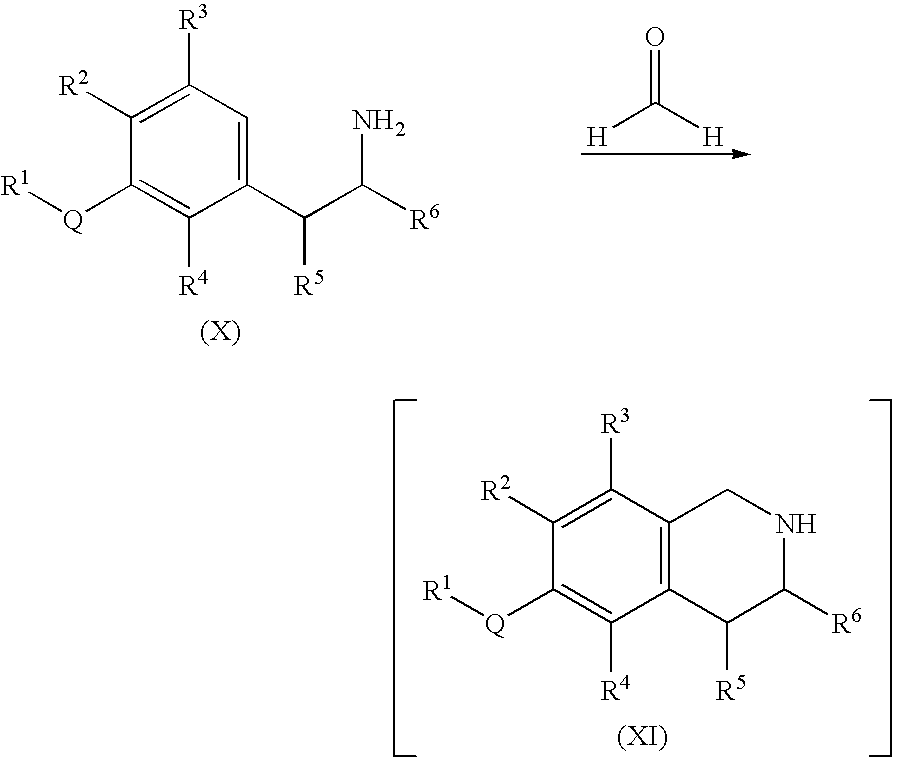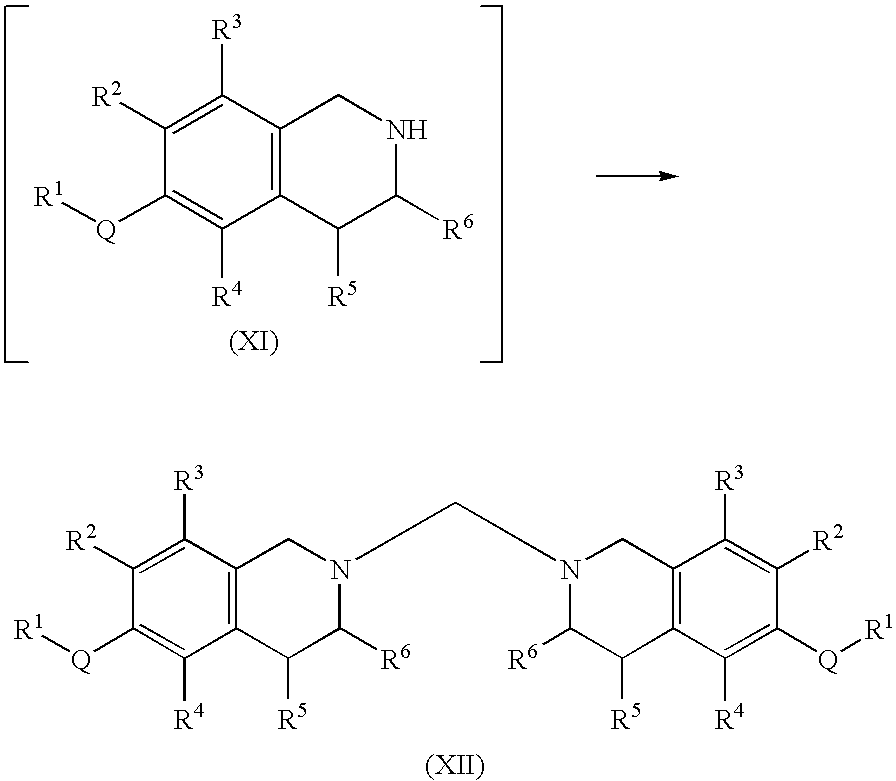Process for the preparation of substituted-1,2,3,4-tetrahydroisoquinoline derivatives
a technology of tetrahydroisoquinoline and substituted 1, 2, 3, 4tetrahydroisoquinoline, which is applied in the field of process for the preparation of substituted1, 2, 3, 4tetrahydroisoquinoline derivatives, can solve the problems of high cost, inconvenient large-scale operation, and inability to synthesise these intermediates
- Summary
- Abstract
- Description
- Claims
- Application Information
AI Technical Summary
Benefits of technology
Problems solved by technology
Method used
Image
Examples
example 1
Bis(6-methoxy-3,4-dihydroisoquinolin-2(1H)-yl)methane
[0132]
[0133]An aqueous solution of formaldehyde (416.5 g, 37% wt., 5.13 mol) was added to a solution of 2-(3-methoxyphenyl)ethylamine (200.0 g, 1.28 mol) in an aqueous 1 N HCl solution (1.92 L, 1.92 mol). The reaction mixture was stirred at 60° C. for 1 hour. The reaction mixture was then cooled to room temperature and basified with 50% NaOH solution (174.4 g, 2.18 mol) in the following order:
[0134](a) 40% of the total amount of NaOH solution was added slowly over 10 minutes and the internal reaction temperature was maintained in the range of 25-30° C. by using an ice-water batch. The resulting light suspension was then stirred at a temperature in the range of 25-30° C. for 1 hour.
[0135](b) Another 15% of the total amount of NaOH solution was then slowly added over 5 minutes while maintaining the internal temperature of the reaction mixture in the range of 25-30° C. The resulting light suspension was stirred at a temperature in th...
example 2
6-Methoxytetrahydroisoquinoline HCl salt
[0145]
[0146]Bis(6-methoxy-3,4-dihydroisoquinolin-2(1H)-yl)methane, prepared as in Example 1 above (213.4 g, 0.63 mol) was suspended in IPA (1.06 L), to which a concentrated aqueous HCl solution (140.4 g, 36% wt., 1.38 mol) was added slowly. Most of the solids were dissolved immediately after the addition of HCl. A solid was re-precipitated in a few seconds afterwards. The resulting suspension was stirred at room temperature for 18 hours. MTBE (530 mL) was added and the suspension was stirred at room temperature for an additional 4 hours. The solid was filtered, rinsed with a 1:1 mixture of MTBE:IPA (100 mL), and then air-dried. The title compound was obtained as a white solid.
[0147]Melting Point: 239° C. (by DSC analysis)
[0148]1H NMR (300 MHz, DMSO-d6): δ 7.13 (d, J=8.4 Hz, 1H), 6.81 (d, J=8.4, 2.6 Hz, 1H), 6.79 (s, 1H), 3.77 (s, 6H), 4.14 (br s, 2H), 3.73 (s, 3H), 3.10 (br m, 2H), 2.50 (t, J=1.6 Hz, 2H)
[0149]13C NMR (300 MHz, DMSO-d6): δ 158....
example 3
Bis(7,8-dihydro-[1,3]dioxolo[4,5-g]isoquinolin-6(5H)-yl)methane
[0153]
[0154]An aqueous solution of formaldehyde (4.165 g, 37% wt., 51.3 mmol) was added to a solution of 3,4-methylenedioxyphenethylamine HCl (2.158 g, 98% wt., 10.5 mmol) in an aqueous 1 N HCl solution (19.2 mL, 19.2 mmol). The reaction mixture was stirred at 40° C. for 18 hours. The reaction mixture was then cooled to room temperature and basified with an aqueous 3 N NaOH solution (7.3 mL, 21.8 mmol) in portions as follows: (a) 40% of the total amount of NaOH solution was added slowly over 10 minutes, and the resulting light suspension was stirred at 25-30° C. for 1 hour; (b) 15% of the total amount of NaOH solution was added slowly over 5 minutes, and the resulting light suspension was stirred at 25-30° C. for 1 hour; (c) another 15% of the total amount of NaOH solution was added slowly over 5 minutes, and the resulting light suspension was stirred at 25-30° C. for 1 hour; (d) the final 30% of the total amount of NaOH...
PUM
| Property | Measurement | Unit |
|---|---|---|
| temperature | aaaaa | aaaaa |
| temperature | aaaaa | aaaaa |
| temperature | aaaaa | aaaaa |
Abstract
Description
Claims
Application Information
 Login to View More
Login to View More - R&D
- Intellectual Property
- Life Sciences
- Materials
- Tech Scout
- Unparalleled Data Quality
- Higher Quality Content
- 60% Fewer Hallucinations
Browse by: Latest US Patents, China's latest patents, Technical Efficacy Thesaurus, Application Domain, Technology Topic, Popular Technical Reports.
© 2025 PatSnap. All rights reserved.Legal|Privacy policy|Modern Slavery Act Transparency Statement|Sitemap|About US| Contact US: help@patsnap.com



